

Windows Server 2012 Active Directory Moves Forward. I just returned from Microsoft’s annual Most Valuable Professional (MVP) Summit, where recipients of Microsoft's award for technical expertise and community service in various disciplines get together with Microsoft product groups, various speakers, and one aother for a week of tech talk and futures.

In the Directory Services breakout—my category—I never really expect to learn anything radical from year to year. The excitement of the topic usually depends on whether a new OS is being released and how big that release is. But this year, I put check marks in both the "new release" and "big release" columns, so there was some serious learning to be done. In this month's column, I'm going to review the major identity and security changes that Microsoft has incorporated into Windows Server 2012.
Mind you, these changes qualify as evolutionary rather than revolutionary; they build on and extend the solid Active Directory (AD) foundation that we already have. How to upgrade windows 2008 R2 Active Directory to windows 2012 Active directory - Direct Experts Blog. Migration Active Directory vers Windows Server 2012 - Le blog d'Alexandre GIRAUD MVP Forefront. Maintenant que Windows Server 2012 est disponible, vous allez être amené très certainement à souhaiter migrer vers cette dernière version pour bénéficier des nouvelles fonctionnalités.
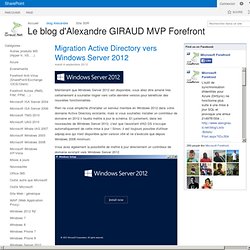
Rien ne vous empêche d'installer un serveur membre en Windows 2012 dans votre domaine Active Directory existante, mais si vous souhaitez installer un contrôleur de domaine en 2012 il faudra mettre à jour le schéma. Et justement, dans les nouveautés de Windows Server 2012, c'est que l'assistant d'AD DS s'occupe automatiquement de cette mise à jour !
Sinon, il est toujours possible d'utiliser adprep.exe qui n'est disponible qu'en version x64 et ne s'exécute que depuis Windows 2008 minimum. Ricardo Szyfer » Migrating Windows Server 2003 to Windows Server 2012 – Part 1. 1.
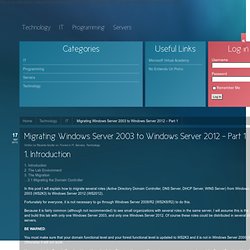
Introduction2. The Lab Environment3. The Migration…3.1 Migrating the Domain Controller. Quick Guide: What's New in Windows Server 2012 Active Directory. Windows Insider Quick Guide: What's New in Windows Server 2012 Active Directory You can divide the "what's new" categories in Windows Server 2012 Active Directory into two roughly equal parts: brand new and merely improved.
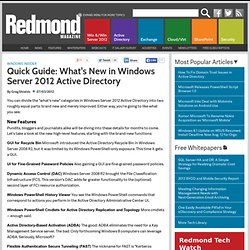
Either way, you're going to like what you see. New Features Pundits, bloggers and journalists alike will be diving into these details for months to come. Let's take a look at the new high-level features, starting with the brand-new functions: GUI for Recycle Bin Microsoft introduced the Active Directory Recycle Bin in Windows Server 2008 R2, but it was limited by its Windows PowerShell-only exposure. UI for Fine-Grained Password Policies Also gaining a GUI are fine-grained password policies. Quick Guide: What's New in Windows Server 2012 Active Directory. Add Windows Server 2012 As A Domain Controller. Install a domain controller in a remote site. You can create an additional domain controller in a domain by installing Active Directory Domain Services (AD DS) on a server computer.

When you are placing the additional domain controller in a remote site, you can install AD DS on the server either before or after you ship it to the remote site, as follows: Ship the computer as a workgroup computer, and install AD DS on it in the remote site. If you do not have administrative support in the remote site, enable Remote Desktop on the computer before you ship the computer so that you can perform the installation remotely.
In the remote site, you can either: Install AD DS from installation media that has been shipped to the site on removable media.Install AD DS over the network.Install AD DS on the server in a hub or staging site, and then ship the installed domain controller to the remote site. - Objects that were modified, added, or deleted since the installation media was created must be replicated. Ntdsutil activate instance ntds. How install from media (IFM) really works (Part 1) « Christoffer Andersson. This is the first blog post in a series of posts covering how the “Install from media” feature really works, it’s an in-depth very technical post that explains what happens under the hood and this first part focuses on how it works in Windows Server 2003.

Background Install from media was first introduced in Windows Server 2003, as a solution to improve the installation experience of newly promoted domain controllers in branch offices mainly (or sites with slow-links where the initial replication could take significant time to complete), but it is actually an important component in many disaster recovery plans I have designed for various customers over the years, As it is a fast and efficient way to re-install a domain controller and get it up to sync, (that’s the proper way to handle a faulting replicas/domain controllers in most cases). What dose Install from media (IFM) consist of Install from media (IFM) contains two important things. Table 4: DCPROMOUI.log Table 6: NTFRS.JDB IDTable. Introducing the first Windows Server 2012 Domain Controller (Part 1 of 2) - Ask Premier Field Engineering (PFE) Platforms. **Update – Before you introduce that first 2012 DC view our new series on AD upgrades** Greg Jaworski here again to discuss introducing the first Windows Server 2012 Domain Controller.
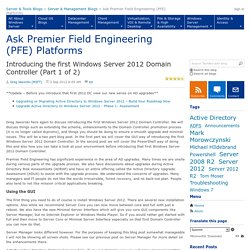
We will discuss things such as extending the schema, enhancements to the Domain Controller promotion process (it is no longer called dcpromo), and things you should be doing to ensure a smooth upgrade and minimal issues. This will be a two part blog post. In the first part we will cover the GUI way of introducing the first Windows Server 2012 Domain Controller. In the second post we will cover the PowerShell way of doing this and also how you can take a look at your environment before introducing that first Windows Server 2012 Domain Controller. Premier Field Engineering has significant experience in the area of AD upgrades. Using the GUI. Upgrading Windows Server 2008 Active Directory to 2012? Read more …….. - Blain Barton's Blog. Sign in Blain Barton's Blog Senior IT Pro Evangelist - Microsoft TechNet Community.

Upgrading or Migrating Active Directory to Windows Server 2012 – Build Your Roadmap Now - Ask Premier Field Engineering (PFE) Platforms. **Be sure to read the entire series on the AD Upgrade** If you’ve been managing an Active Directory infrastructure for the last 5-10 years, you might have noticed that the pace of change has rapidly increased.
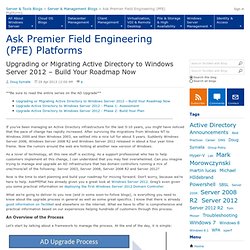
After surviving the migrations from Windows NT to Windows 2000 and then Windows 2003, we settled into a nice lull for about 5 years. Suddenly Windows Server 2008, Windows Server 2008 R2 and Windows Server 2012 released in about a four year time frame. Now the rumors around the web are hinting at another new version of Windows. As a lover of technology, all this new stuff is exciting. Now is the time to start planning and build your roadmap for moving forward. What we’re going to deliver to you now (and in some soon-to-follow blogs), is everything you need to know about the upgrade process in general as well as some great specifics. An Overview of the Process Let’s start by talking about a framework to manage the process. Upgrading or Migrating Active Directory to Windows Server 2012 – Build Your Roadmap Now - Ask Premier Field Engineering (PFE) Platforms.
**Be sure to read the entire series on the AD Upgrade** If you’ve been managing an Active Directory infrastructure for the last 5-10 years, you might have noticed that the pace of change has rapidly increased.
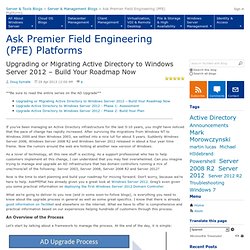
After surviving the migrations from Windows NT to Windows 2000 and then Windows 2003, we settled into a nice lull for about 5 years. Suddenly Windows Server 2008, Windows Server 2008 R2 and Windows Server 2012 released in about a four year time frame. Now the rumors around the web are hinting at another new version of Windows. As a lover of technology, all this new stuff is exciting. Now is the time to start planning and build your roadmap for moving forward. What we’re going to deliver to you now (and in some soon-to-follow blogs), is everything you need to know about the upgrade process in general as well as some great specifics. An Overview of the Process Let’s start by talking about a framework to manage the process. Assess Your Environment. Upgrade Domain Controllers to Windows Server 2012. Windows Server 2012 requires a Windows Server 2003 forest functional level. Install Active Directory AD DS in Server 2012 with IFM Media.
In this blog we will explore how to add a Windows Server 2012 replica Domain Controller using Install From Media (IFM) method. For More see: Establishing an AD DS Forest Adding a replica Domain Controller to an existing AD DS Domain When we promote a server to become a replica domain controller, it will require connectivity to another domain controller to copy the active directory database from. If the server that is being promoted is located in a remote location the database will be copies of the WAN link. If the link is slow and the database is large this could take a long time. To minimize WAN traffic the database can be made available through removable media and then used by the server during the promotion process.
Install an Additional Domain Controller from IFM (Install From Media) in Windows Server 2012. We can use the Install from media (IFM) option to install an Additional Domain Controller in an existing domain is the best option such as a branch office scenario where network is slow, unreliable and costly. IFM will minimize replication traffic during the installation because it uses restored backup files to populate the AD DS database. This will significantly reduce the amount of traffic copied over the WAN link. For this Installation process, we have to follow these steps: On the Primary Domain Controller (KTM-DC01-2K12), Create Installation media using Ntdsutil.exe.Add the AD DS role to the member serverSelect Install from Media option to configure a member server as a new domain controller. Step 1: To Create Installation Media Using Ntdsutil, follow these steps: 1. 2. 3. 4. 5.
Steps 2: Add the AD DS role to the member server (POK-DC01-2K12): 1. 2. Windows Server 2012 Hyper-V: How to clone a Virtual Domain Controller. Windows Server 2012 Hyper-V: How to clone a Virtual Domain Controller Posted in Active Directory, Hyper-V, IT, Microsoft, Powershell, Private Cloud, Virtualization, VMware, Web, Windows Server, Windows Server 2012, Work Physical DC is required for Windows Server 2008 R2 ClustersNo Snapshots of virtual Domain ControllersNo cloning of virtual Domain ControllersNo online V2V migration via SnapshotsNo restoring of virtual Domain Controller VMs In Windows Server 2012 Microsoft included a new feature for Active Directory Domain Controllers called VM-GenerationID. At the moment you can use this feature with Windows Server 2012 Hyper-V as a hypervisor, but Microsoft also offers other hypervisor vendors to integrate this feature. TechNet: Safe virtualization of domain controllers Another problem was solved by Active Directory-less Cluster Bootstrapping.
Windows Server 2012 Simplifies Active Directory Upgrades and Deployments. Extending the AD schema to support either a new OS release or Active Directory (AD)-integrated applications that require it (e.g., Exchange Server) is a regular—if infrequent—administrative task. And these kinds of schema upgrades have always made AD administrators nervous. It's not because admins have personal experience with schema upgrades gone bad; if you ask 500 AD admins if they've personally had a bad schema-upgrade experience, 499 of them will admit they haven't. What makes AD admins wary is the fact that upgrading the AD schema can be confusing, and it's irreversible. Anything that affects the entire Windows authentication and authorization infrastructure, and has no "undo" button, is a process to be careful about. How to view and transfer FSMO roles in Windows Server 2003. Upgrading an Active Directory Domain from Windows Server 2003 or Windows Server 2003 R2 to Windows Server 2012 - MWeber's Blog.
A new OS Domain Controller installation should always start with the support tools, to check the Domain and Domain Controllers for errors that must be resolved before. The following command line tools and programs will help you to verify if some problems exist within your Domain and the Domain Controllers. Dcdiag /v /c /d /e /s:DCName >c:\dcdiag.log [please replace DCName with your Domain Controller name]